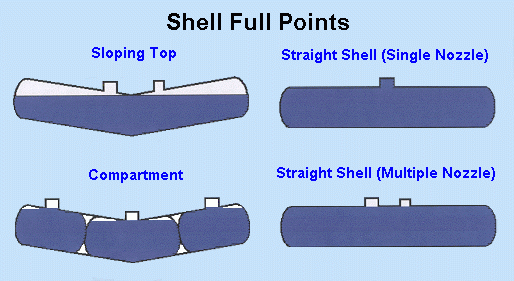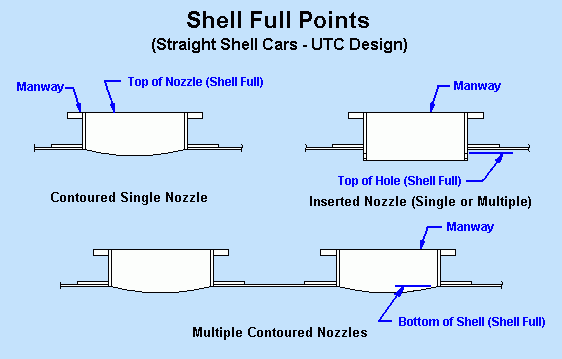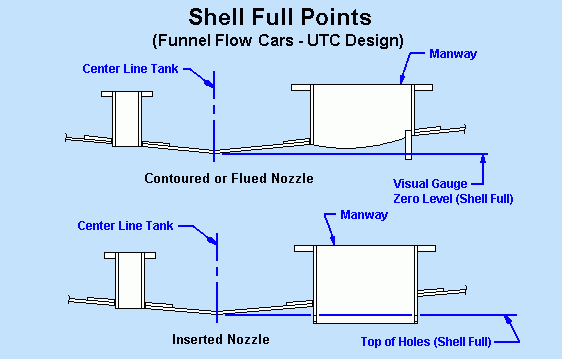

 |
 |
|
Tank Car Gauging and Gauge Tables |
| To operate tank cars, it is important to understand tank car gauging and the use of gauge tables. Gauging is used while loading and unloading tank cars to measure the amount of product being shipped. It is also used to determine outage and filling limits to prevent overloading a tank. Following is an overview of tank car gauging, beginning with calibrating a tank, gauging a tank, the use of gauge tables, and then determining outage and filling limits for shipment. | |
|
CALIBRATION In order to gauge a tank car for shipment, the shell-full capacity of each tank must be measured. Calibration is a method used to determine the volume capacity of a tank car tank. Each tank is calibrated to accurately measure its shell-full capacity. There are three methods of calibration, which are covered in API Standard 2554 "Measurement and Calibration of Tank Cars": |
|
| 1) | Water Gauge Plant Procedure: Capacity is determined by filling the tank with a quantity of water measured by discharge from a calibrated tank or tanks. |
| 2) | Water-Weighing Procedure: Capacity is determined by filling the tank with water and weighing the car before and after filling. |
| 3) | "Strapping" Procedure: Capacity is determined by computing the volume from external measurements of the tank and deducting for the thickness of walls, laps, etc. |
|
Shell-Full: To determine a tank’s capacity, the shell-full points must be defined. This is the point to which a tank is filled during calibration. As published in the AAR Manual of Standards and Recommended Practices, Section C-III, Specifications for Tank Cars, M-1002, issue of December, 2000, effective for all cars constructed after May 1, 2001, the definition of shell-full is: |
||
| "The liquid volume at the transition point at which air or vapor becomes entrapped in a location that is not in direct communication with all top fittings." | ||
| Using this definition of shell-full, the following figures illustrate the shell-full points for various types of tanks: | ||

|
||

|
||

|
||
| The shell-full volume is not to be used when calculating the filling density of the lading. A tank is calibrated to accurately measure its capacity. A tank is gauged to determine the quantity of liquid loaded into it. | ||
|
GAUGING Shippers and operators of tank cars must be able to determine the proper outage and filling limits for shipping their products. Gauging is a method used to determine the quantity of a product loaded into a tank car tank. It is used for both loading and unloading to assure proper levels are reached. Tank car tanks can be gauged by built-in gauge marker, electronic or magnetic gauging device, telltale valve, or slip tube. Gauging can also be accomplished by scale weighing, liquid metering, or by use of poles and outage/innage tables, depending on the commodity and class of car. Procedures for gauging tank car tanks are detailed in API Measurement Standard 3.2, Tank Gauging – Standard Practice for Gauging Petroleum and Petroleum Products in Tank Cars. |
||
|
GAUGE TABLES Once the shell-full capacity of a tank is determined by water gauging, a gauge table is assigned to each tank car. Per AAR Manual C-III, for all cars constructed after May 1, 2001, gauged capacities shall be rounded to the nearest 10 gallon and 50 liter increments. The rounded capacity is used in assigning gauge tables. A gauge table (also referred to as a capacity table, outage table, innage table, strapping table) is a chart showing the tank car capacities or volumes for various liquid levels measured at the reference gauge point. Gauge tables are calculated based on the design and capacity of each tank. Tables are to be used as a guide for loading and unloading tanks, and also to prevent overloading (filling) of the tank. Per AAR Manual C-III, for all cars constructed after May 1, 2001, gauge tables shall be provided by the car builder and shall conform to the following: |
|
|
|
Tables shall list outage volumes (volume of air or vapor above the surface of a liquid) corresponding to distances measured downward from the shell-full (zero-outage) level. |
|
|
Tables shall begin at the shell-full (zero-outage) level and continue for the full depth of the tank. |
|
|
If English units are used, volumes shall be whole U.S. gallons and distances shall be inches in one-quarter-inch increments. If metric units are used, volumes shall be whole liters and distances shall be whole centimeters. |
|
|
All tables must show an effective date. |
| Tables assigned to cars constructed prior to May 1, 2001, may not conform to the above specifications. | |
|
Assigning Gauge Tables: Every UTC tank car is assigned an outage table after water gauging is completed. Each order of cars is set up based on the design of the tank and the estimated capacity of the tank. Per AAR Manual C-III, tank cars may be grouped when assigning gauge tables if the measured shell-full capacity of the tank is within 0.1% of the shell-full capacity used in the gauge table. Any car with a gauged capacity that fits into that range will be assigned the same table. |
||||||||||||||||||
| Sample Range: | 24,975 (Low) | |||||||||||||||||
| 25,000 (Actual Table Capacity) | ||||||||||||||||||
| 25,025 (High) | ||||||||||||||||||
| Using this procedure, a group of like cars being constructed at the same time may only have 2 or 3 tables assigned for all of the cars. The outage table number is applied to all newly constructed UTC tank cars near the consolidated stencil. | ||||||||||||||||||
|
Using Gauge Tables: Gauge tables are used as a guide for loading and unloading tank cars. The zero-point on a gauge table corresponds with the shell-full point at the top of the tank. Starting at the shell full-point, measure down the depth of the tank. An outage table will indicate the amount of product that is out of the tank at each one-quarter-inch increment. Innage tables are just the opposite. Starting from the shell-full point, an innage table will indicate the amount of product that is still in the tank at each one-quarter-inch increment. Union Tank Car provides outage tables as standard. This is to aid at loading when determining the percent outage that is to be maintained for the product being shipped. See the section on filling limits for information on determining outage and filling limits. An outage table can be used to determine the amount of product that is still in the tank. Simply subtract the amount (gallons) that is out of the tank at a certain level from the total capacity of the tank car. The result will be how many gallons are still in the tank. |
||||||||||||||||||
|
Using the table shown below for a 22,800 gallon tank car, at 28" outage in
gallons is 4,856, therefore, there are 17,944 gallons remaining in the tank. PORTION OF A TYPICAL OUTAGE TABLE: |
||||||||||||||||||
|
||||||||||||||||||
|
Accessing Gauge Tables: To access current gauge tables for all UTC built tank cars Click Here. At the outage selection screen, enter either an outage table number or a UTLX car number. Tables may be viewed in either inches or centimeters, and volume in liters, imperial gallons or U.S. gallons may also be selected. |
||||||||||||||||||
|
FILLING LIMITS Outage and filling limits for bulk packagings (tank cars) are based on many variables, including product type, density of the product, and temperature of the product. The regulations for outage and filling limits are covered in the Bureau of Explosives Tariff No. BOE-6000 under Paragraph 173.24b(a) and Paragraph 173.314(c). |
|
| Paragraph 173.24b(a) | |
| For products covered under this paragraph, the following outage requirements apply: | |
|
|
5% outage for materials poisonous by inhalation |
|
|
1% outage for all other materials |
| At the following reference temperatures: | |
|
|
46°C (115°F) for non-insulated tanks |
|
|
43°C (110°F) for thermally protected tanks |
|
|
41°C (105°F) for insulated tanks |
| Paragraph 173.314(c) | |
|
For outage requirements of products covered under this paragraph, refer to the
table in the BOE 6000 manual listing proper shipping name, outage and filling
limits and authorized tank car class. In addition to the reference temperatures
listed in Paragraph 173.24b(a), temperature requirements for the winter months
(November – March) are listed in Paragraph 173.314(c). For all tank car classes, the percent outage must be maintained at the reference temperatures listed above. Allowances must be made for expansion of the product due to temperature increases that may affect the outage. Of course, there are exceptions to every rule and you may find other special provisions in the BOE 6000 manual. In addition to maintaining the required outage, weight must also be considered when loading a tank. The weight of a car must not exceed the maximum gross rail load limit. Therefore, tanks carrying heavier products may not be able to be filled to the same level as a lighter product. Outage tables are provided to assist the shipper in determining the correct filling level. It is the shipper’s responsibility to know their product and to determine these levels. |
|
|
Note: The above information has been sourced from the Union Tank Car Company Blue Book, Tank Car Gauging and Gauge Tables section. As indicated, gauge tables are used as a guide. For precise measurements, a metering system should be used. Updated : Jan-07-2003 |
|